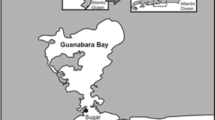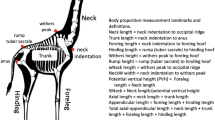Abstract
Sexual size dimorphism is a common phenomenon in the animal kingdom, and its seasonal change has been reported in some species that possess traits dimorphic only in males and specialized for male mating success. However, few studies have examined seasonal change in sexual dimorphism of traits possessed by both sexes. Here, we examined the reproductive biology of the hermit crab Pagurus minutus, at a sandflat in the Waka River estuary, Japan, with special reference to seasonal changes in sexual dimorphism of the large claw (major cheliped) size by conducting population and precopulatory guarding-pair sampling. Previous investigation demonstrated that the major cheliped is used as a weapon, and its size, more than body size, determines the winner in male–male contests of this species. We found ovigerous females from November to April, peaking in January, when 80% of females were ovigerous. Sexual size dimorphism of the major cheliped was observed; the degree of dimorphism increased in the reproductive season, when only males possessed an enlarged major cheliped. In addition, in the reproductive season, precopulatory guarding males had a larger body and larger relative size of the major cheliped than did solitary males, although the major cheliped size in guarding males seemed to reach an upper limit. These results suggest that seasonal change in sexual dimorphism of the major cheliped size in P. minutus strongly reflects sexual selection favoring the development of this natural weaponry, and that the degree of the dimorphism might be limited through natural selection.






Similar content being viewed by others

References
Allen BJ, Levinton JS (2007) Costs of bearing a sexually selected ornamental weapon in a fiddler crab. Funct Ecol 21:154–161
Andersson M (1994) Sexual selection. Princeton University Press, Princeton
Asakura A (1987) Population ecology of the sand-dwelling hermit crab Diogenes nitidimanus Terao: 3. Mating system. Bull Mar Sci 41:282–288
Basolo AL, Alcaraz G (2003) The turn of the sword: length increases male swimming costs in swordtails. P Roy Soc B Biol Sci 270:1631–1636
Berglund A, Bisazza A, Pilastro A (1996) Armaments and ornaments: an evolutionary explanation of traits of dual utility. Biol J Linn Soc 58:385–399
Blackstone NW (1985) The effects of shell size and shape on growth and form in the hermit crab Pagurus longicarpus. Biol Bull 168:75–90
Briffa M, Dallaway D (2007) Inter-sexual contests in the hermit crab Pagurus bernhardus: females fight harder but males win more encounters. Behav Ecol Sociobiol 61:1781–1787
Bueno SLS, Shimizu RM (2009) Allometric growth, sexual maturity, and adult male chelae dimorphism in Aegla franca (Decapoda: Anomura: Aeglidae). J Crust Biol 29:317–328
Butler MJ, Stein RA (1985) An analysis of the mechanisms governing species replacements in crayfish. Oecologia 66:168–177
Candolin U (1999) Male–male competition facilitates female choice in sticklebacks. P Roy Soc B Biol Sci 266:785–789
Contreras-Garduño J, Córdoba-Aguilar A (2006) Sexual selection in hermit crabs: a review and outlines of future research. J Zool 270:595–605
Crane J (1975) Fiddler crabs of the world: Ocypididae: genus Uca. Princeton University Press, New York
Doake S, Scantlebury M, Elwood RW (2010) The costs of bearing arms and armour in the hermit crab Pagurus bernhardus. Anim Behav 80:637–642
Duffy JE, Thiel M (2007) Evolutionary ecology of social and sexual systems: crustaceans as model organisms. Oxford University Press, New York
Emlen DJ (2008) The evolution of animal weapons. Annu Rev Ecol Evol Syst 39:387–413
Endler JA (1980) Natural selection on color patterns in Poecilia reticulata. Evolution 34:76–91
Fleming IA, Gross MR (1994) Breeding competition in a Pacific salmon (Coho: Oncorhynchus kisutch): measures of natural and sexual selection. Evolution 48:637–657
Fotheringham N (1976) Effects of shell stress on the growth of hermit crabs. J Exp Mar Biol Ecol 23:299–305
Goshima S, Kawashima T, Wada S (1998) Mate choice by males of the hermit crab Pagurus filholi: do males assess ripeness and/or fecundity of females? Ecol Res 13:151–161
Guiasu RC, Dunham DW (1998) Inter-form agonistic contests in male crayfishes, Cambarus robustus (Decapoda, Cambaridae). Invertebr Biol 117:144–154
Hendry AP, Berg OK (1999) Secondary sexual characters, energy use, senescence, and the cost of reproduction in sockeye salmon. Can J Zool 77:1663–1675
Hunt J, Breuker CJ, Sadowski JA, Moore AJ (2009) Male–male competition, female mate choice and their interaction: determining total sexual selection. J Evol Biol 22:13–26
Imafuku M (1986) Sexual discrimination in the hermit crab Pagurus geminus. J Ethol 4:39–47
Imafuku M (1989) Shell fights in the hermit crab Pagurus geminus: effect of cheliped use and shell rap**. J Ethol 7:35–39
Juanes F, Smith LD (1995) The ecological consequences of limb damage and loss in decapod crustaceans: a review and prospectus. J Exp Mar Biol Ecol 193:197–223
Kawaminami T, Goshima S (2015) Guarding males of the hermit crab climb up algae to avoid male–male competition. J Ethol 33:25–33
Koga T, Backwell PRY, Christy JH, Murai M, Kasuya E (2001) Male-biased predation of a fiddler crab. Anim Behav 62:201–207
Koga T, Yoshino K, Fukuda Y (2010) Temporal changes in the reproductive population structures and male’s secondary sexual character of the hermit crab Diogenes nitidimanus. Ecol Res 25:1007–1017
Lee SY (1995) Cheliped size and structure: the evolution of a multi-functional decapod organ. J Exp Mar Biol Ecol 193:161–176
Lee SY, Seed R (1992) Ecological implications of cheliped size in crabs: some data from Carcinus maenas and Liocarcinus holsatus. Mar Ecol Prog Ser 84:151–160
Magnhagen C (1991) Predation risk as a cost of reproduction. TREE 6:183–186
Mariappan P, Balasundaram C, Schmitz B (2000) Decapod crustacean chelipeds: an overview. J Bioscience 25:301–313
Matsuo K, Tanikawa D, Yasuda CI, Wada S (2015) Sex-related differences in size, function and regeneration of the major cheliped in the hermit crab Pagurus filholi. Mar Ecol 36:1391–1399
Minouchi S, Goshima S (1998) Effect of male/female size ratio on mating behavior of the hermit crab Pagurus filholi (Anomura: Paguridae) under experimental conditions. J Crust Biol 18:710–716
Moen RA, Pastor J, Cohen Y (1999) Antler growth and extinction of Irish elk. Evol Ecol Res 1:235–249
Nakano R, Yasuda CI, Koga T (2016) Temporal changes in egg number and size during a single breeding season in the hermit crab Pagurus minutus. Jpn J Benthol 71:32–36
Neil SJ (1985) Size assessment and cues: studies of hermit crab contests. Behaviour 92:22–37
Okamura S, Goshima S (2010) Indirect female choice mediated by sex pheromones in the hermit crab Pagurus filholi. J Ethol 28:323–329
Panhuis TM, Wilkinson GS (1999) Exaggerated male eye span influences contest outcome in stalk-eyed flies (Diopsidae). Behav Ecol Sociobiol 46:221–227
R Core Team (2015) R: a language and environment for statistical computing, Version 3.2.3. https://www.R-project.org
Shaffer SA, Weimerskirch H, Costa DP (2001) Functional significance of sexual dimorphism in Wandering Albatrosses, Diomedea exulans. Funct Ecol 15:203–210
Shine R (1989) Ecological causes for the evolution of sexual dimorphism: a review of the evidence. Q Rev Biol 64:419–461
Stein RA, Murphy ML, Magnuson JJ (1977) External morphological changes associated with sexual maturity in the crayfish (Orconectes propinquus). Am Midl Nat 97:495–502
Suzuki Y, Yasuda C, Takeshita F, Wada S (2012) Male mate choice and male–male competition in the hermit crab Pagurus nigrofascia: importance of female quality. Mar Biol 159:1991–1996
Wada S, Sonoda T, Goshima S (1996) Temporal size covariation of mating pairs of the hermit crab Pagurus middendorffii (Decapoda: Anomura: Paguridae) during a single breeding season. Crust Res 25:158–164
Wada S, Tanaka K, Goshima S (1999) Precopulatory mate guarding in the hermit crab Pagurus middendorffii (Brandt) (Decapoda: Paguridae): effects of population parameters on male guarding duration. J Exp Mar Biol Ecol 239:289–298
Weckerly FW (1998) Sexual-size dimorphism: influence of mass and mating systems in the most dimorphic mammals. J Mammal 79:33–52
Wilson RS, James RS, Bywater C, Seebacher F (2009) Costs and benefits of increased weapon size differ between sexes of the slender crayfish, Cherax dispar. J Exp Biol 212:853–858
Yasuda CI, Koga T (2016) Importance of weapon size in all stages of male–male contests in the hermit crab Pagurus minutus. Behav Ecol Sociobiol 70:2175–2183
Yasuda C, Suzuki Y, Wada S (2011) Function of the major cheliped in male–male competition in the hermit crab Pagurus nigrofascia. Mar Biol 158:2327–2334
Yasuda C, Takeshita F, Wada S (2012) Assessment strategy in male–male contests of the hermit crab Pagurus middendorffii. Anim Behav 84:385–390
Yasuda CI, Matsuo K, Wada S (2014) Rapid regeneration of the major cheliped in relation to its function in male–male contests in the hermit crab Pagurus middendorffii. Plankton Benthos Res 9:122–131
Yoshino K, Goshima S (2002) Sexual dominance in hermit crab shell fights: asymmetries in owner-intruder status, crab size, and resource value between sexes. J Ethol 20:63–69
Zuk M, Kolluru GR (1998) Exploitation of sexual signals by predators and parasitoids. Q Rev Biol 73:415–438
Acknowledgements
We thank Hiroaki Tamura for his assistance with the analyses and two anonymous reviewers for their valuable comments on the manuscript.
Author information
Authors and Affiliations
Corresponding author
Ethics declarations
Conflict of interest
The authors declare that they have no conflict of interest.
Compliance with ethical standards
The study was conducted according to the ASAB/ABS guidelines for the ethical treatment of animals. Sample size was minimized throughout the study. Since the species studied is common in tidal flats of Japan and is not endangered, no specific permits were required for this research.
Funding
This study was funded by a Japan Society for the Promotion of Science Research Fellowship for Young Scientists (Grant Number 25-2149 and 15J07721) to CIY.
About this article
Cite this article
Yasuda, C.I., Otoda, M., Nakano, R. et al. Seasonal change in sexual size dimorphism of the major cheliped in the hermit crab Pagurus minutus . Ecol Res 32, 347–357 (2017). https://doi.org/10.1007/s11284-017-1438-3
Received:
Accepted:
Published:
Issue Date:
DOI: https://doi.org/10.1007/s11284-017-1438-3



